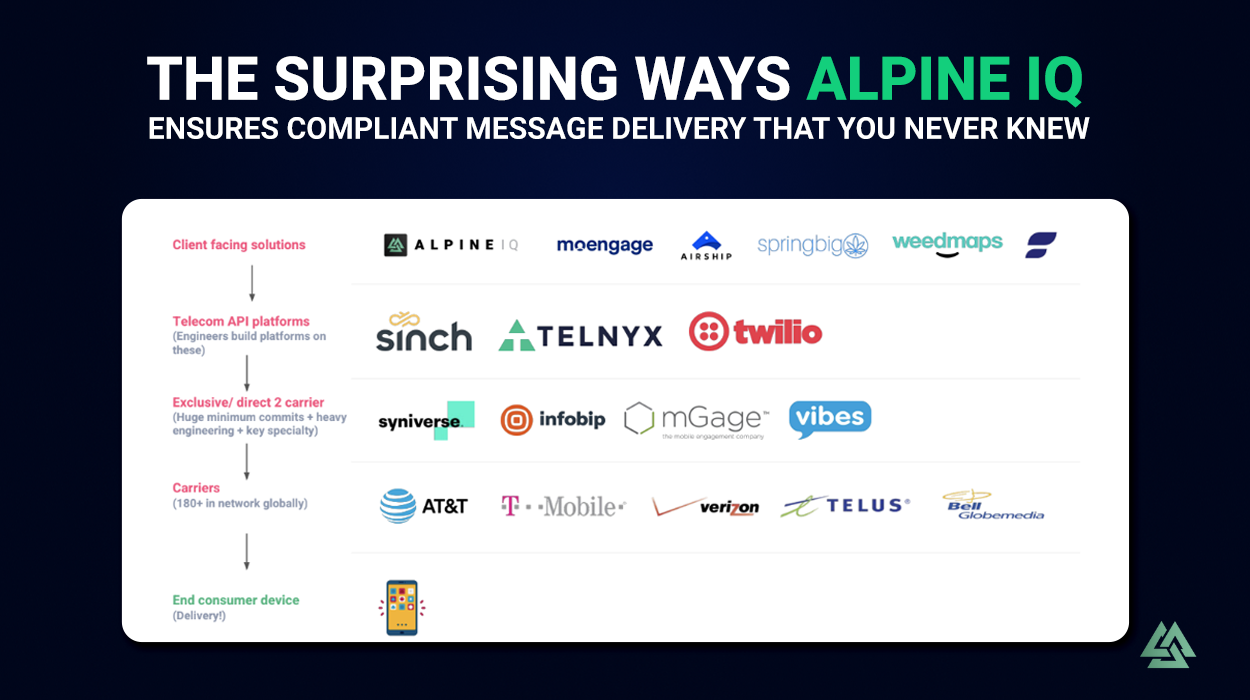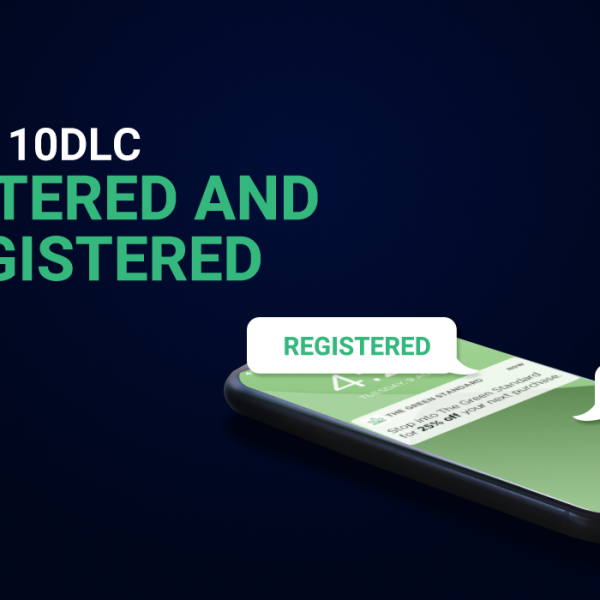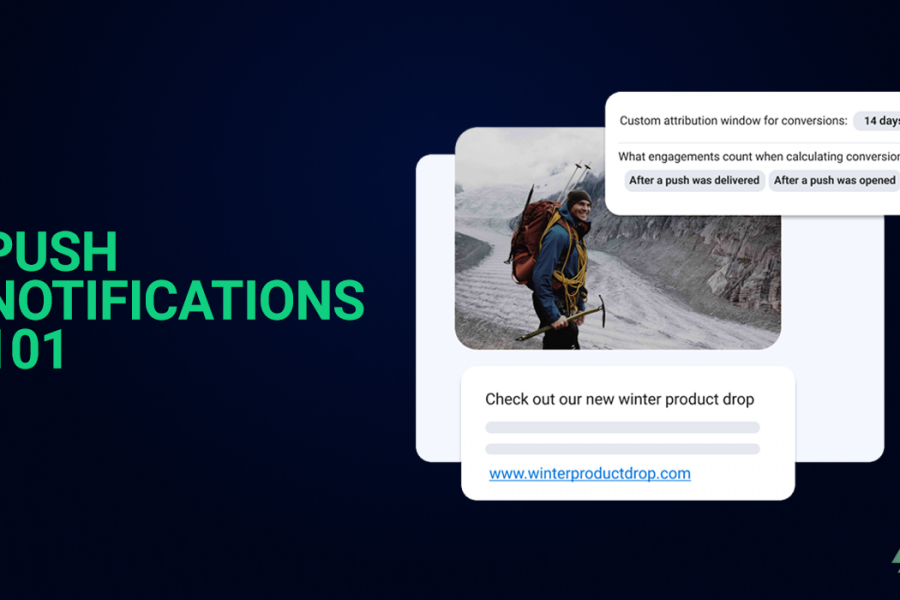Have you ever wondered how text messages get to you? It’s a complex process that involves many different players, all working together to make sure your messages are delivered quickly and reliably.
For highly regulated messages, in particular, there are a few extra steps that need to be taken to ensure compliance with regulations. Here’s a quick overview of how messages are routed across the telecom ecosystem, but first, let’s discuss some of the key terms that you’ll need to know.
Glossary of SMS and Telecom-Related Terms:
These are common terms that may come up throughout this post or that are important to know about messages being routed:
Aggregator: A company that provides a bulk SMS (short message service) solution to brands and enterprises.
API: An abbreviation for “Application Programming Interface,” an API is a set of programming instructions that allow software to interact with other software. In the context of messaging, an API would allow a chat app to connect with a carrier in order to send and receive SMS messages.
Carrier: Carriers, or wireless service providers, are the companies that you buy your cell phone service from. Some major carriers are AT&T, Sprint, T-Mobile, and Verizon. They are responsible for building and maintaining the networks that your messages travel on.
Direct-to-carrier: As the term suggests, this is a direct connection between a sender and a carrier. This is the most reliable way to ensure that messages are delivered, but it’s also the most expensive.
Filtration: In the context of this article, filtration is also called message filters. These are special software programs that scan messages for certain keywords or content and can block them from being delivered if they are found to be in violation of regulations.
Routing: In telecoms, routing refers to the process of delivering messages from the sender to the intended recipient.
SMS: An abbreviation for short message service, an SMS refers to a text message that is limited to 160 characters.
Telecom: An abbreviation for telecommunications, telecoms refers to the electronic transmission of data, usually in the form of text or voice messages.
Message Routing: How It Works
So how does a message from a sender (e.g., marketers, companies, etc.) get to the intended recipient?
The short answer is that it’s routed through a network of carriers, but there’s a bit more to it than that. Let’s take a more in-depth look at how it works:
Step 1: Client-Facing Solutions
First off, highly regulated markets must have a different approach to marketing compared to other kinds of brands, and one of the strategies is to partner with a marketing platform like Alpine IQ.
These are called client-facing solutions, which are essentially specialized platforms that attempt to take telecom and repackage it in a way that is more targeted and sophisticated.
In other words, client-facing solutions make it easy for brands to send text messages without having to worry about the technicalities of how it all works. All they need to do is create and set up an account, upload their contacts, and craft their marketing message. The client-facing solution will take care of the rest.
Step 2: Bulk SMS Sending / Telecom API Platforms
Next, the client-facing solution will send the message through an aggregator. As mentioned, aggregators are responsible for delivering bulk SMS messages. They do this by negotiating rates with carriers and then reselling that service to clients, often at a markup.
However, not all client-facing solutions use an aggregator. Some of them have built their own telecom API platforms. Engineers build platforms on top of telecom APIs to make it easy to do things that would be more complex one layer deeper.
Some examples of telecom API platforms include Sinch, Telnyx, and Twilio. These platforms connect the client-facing solution directly to a carrier.
They also need to have minimum commits if you want lower pricing. As we mentioned, minimum commits are the number of messages that a sender must agree to send in order to establish a direct-to-carrier connection.
Step 2.1: Exclusive Direct-to-Carrier Platforms
On a related note, exclusive direct-to-carrier platforms are another type of client-facing solution. These are companies that have built their own telecom infrastructure and have a direct connection to all the major carriers.
With these kinds of platforms, they require huge minimum commits because they’re essentially selling you access to their direct-to-carrier connection.
The advantage of having a direct connection to a carrier is that it’s more reliable, and the messages are more likely to be delivered. However, if you’re building a highly regulated platform, it’s not recommended to use an exclusive direct-to-carrier platform.
This means that they have stricter message filtering systems, and your messages are more likely to get flagged and blocked. Additionally, they are riskier for highly regulated brands because they could get shut down at any time.
Step 3: The Wireless Carrier and Message Delivery
After the client-facing solution sends the message through an aggregator or direct-to-carrier platform, it will eventually reach the wireless carrier. The wireless carrier is the company that provides service to the person who will be receiving the text message.
When the message reaches the carrier, it will go through a few different systems before finally being delivered to the recipient:
Step 3.1: Sender Verification
First, the carrier will check to see if the sender is on its do-not-contact list. If the sender is on the list, then the message will be blocked and the sender will be notified.
The do-not-contact list is a list of telephone numbers that have been explicitly requested not to receive any more marketing messages. Consumers can opt out of receiving marketing messages by replying “STOP” to any text message they receive.
Step 3.2: Filtration
Once the sender has been verified, the carrier will check the message content against its filter system. The filter system is designed to block messages that are considered spam.
If the message is flagged as spam, then it will be blocked and the sender will be notified. If the message is not flagged as spam, then it will be delivered to the recipient.
Step 3.3: Message Delivery
Finally, the message will be delivered to the recipient’s phone. The recipient will see the sender’s phone number and the message content.
It’s important to note that there is no guarantee that the message will be delivered. Even if the sender is verified and the message is not flagged as spam, there is still a chance that the message will be blocked by the carrier.
The reason for this is that carriers have different standards for what they consider to be spam. So, a message that is not considered spam by one carrier may be considered spam by another.
Additionally, carriers often change their filtering systems, so a message that was previously not considered spam may suddenly be flagged as spam. This is why it’s important to use a service like Alpine IQ that can track the delivery of your messages and notify you if there are any problems.
Wrapping It Up
SMS marketing and the technicalities of message routing can be quite complex. However, it’s important to have a basic understanding of how the process works in order to ensure that your messages are being delivered, especially if you’re a brand or retailer.
If you want more information about text message filtration in highly regulated industries, you can check out our latest webinar: Alpine IQ’s Deep Dive: Everything you need to know about text message filtration.
You can also visit https://alpineiq.com/ to learn more!
To get the latest updates on our suite of services, make sure to subscribe to our blog today!







Leave a Comment